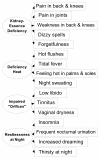Construction of a traditional Chinese medicine syndrome-specific outcome measure: the Kidney Deficiency Syndrome Questionnaire (KDSQ)
- PMID: 22672362
- PMCID: PMC3479037
- DOI: 10.1186/1472-6882-12-73
Construction of a traditional Chinese medicine syndrome-specific outcome measure: the Kidney Deficiency Syndrome Questionnaire (KDSQ)
Abstract
Background: Development of Traditional Chinese Medicine (TCM) syndrome-specific outcome measures is needed for the evaluation of TCM syndrome-specific therapies. We constructed a Kidney Deficiency Syndrome Questionnaire (KDSQ) for the evaluation of the common TCM syndromes Kidney-Yin Deficiency Syndrome (KDS-Yin) and Kidney-Yang Deficiency Syndrome (KDS-Yang) in middle-aged women with menopausal symptoms.
Methods: KDS-Yin and KDS-Yang were traditionally defined by expert opinion were validated by exploratory factor analysis (EFA) and structural equation modeling (SEM). Content validity was tested by EFA on a sample of 236 women from a seminar and SEM on another sample of 321 women from a postal survey. Other psychometric properties were tested on 292 women from the seminar at baseline and two systematically selected sub-samples: 54 who reported no changes in discomforts 11-12 days after the baseline and 31 who reported changes in discomforts 67-74 days after the baseline. All participants completed the KDSQ, the Greene Climacteric Scale and the standard 12-item Short Form Health Survey.
Results: The EFA and SEM established the measurement models of KDS-Yin and KDS-Yang supporting content validity of the KDSQ. Internal consistency was good (Cronbach's Alpha >0.70). Construct validity was supported by theoretically-derived levels of correlation with the established external measures. Test-retest reliability was strong (ICC(agreement): KDS-Yin, 0.94; KDS-Yang, 0.93). The KDSQ was responsive to changes over time as tested by effect size and longitudinal validity.
Conclusions: The KDSQ was a valid and reliable measure for KDS-Yin and KDS-Yang in Hong Kong Chinese middle-aged women with menopausal symptoms.
Figures


Similar articles
-
Symptom characteristics of Kidney-Yin deficiency and Kidney-Yang deficiency in Hong Kong Chinese midlife women.J Altern Complement Med. 2008 Jun;14(5):457-60. doi: 10.1089/acm.2007.7202. J Altern Complement Med. 2008. PMID: 18532896 No abstract available.
-
An evidence-based validation of traditional Chinese medicine syndromes.Complement Ther Med. 2010 Oct;18(5):199-205. doi: 10.1016/j.ctim.2010.05.036. Epub 2010 Aug 17. Complement Ther Med. 2010. PMID: 21056843
-
Traditional Chinese medicine diagnoses in persons with ketamine abuse.J Tradit Chin Med. 2013 Apr;33(2):164-9. doi: 10.1016/s0254-6272(13)60119-3. J Tradit Chin Med. 2013. PMID: 23789211
-
[Progress on the research of prevention and treatment of female climacteric syndrome by traditional Chinese medicine].Zhongguo Zhong Yao Za Zhi. 2005 Mar;30(6):414-8. Zhongguo Zhong Yao Za Zhi. 2005. PMID: 15810442 Review. Chinese.
-
The correlation between traditional Chinese medicine constitution and primary osteoporosis: A systematic review and meta-analysis.Medicine (Baltimore). 2024 Sep 13;103(37):e39560. doi: 10.1097/MD.0000000000039560. Medicine (Baltimore). 2024. PMID: 39287293 Free PMC article.
Cited by
-
Risk of subsequently developing lower urinary tract symptoms in patients with plantar fasciitis: A nationwide, population-based study.Medicine (Baltimore). 2025 Jul 18;104(29):e43349. doi: 10.1097/MD.0000000000043349. Medicine (Baltimore). 2025. PMID: 40696681 Free PMC article.
-
Reliable multi-label learning via conformal predictor and random forest for syndrome differentiation of chronic fatigue in traditional Chinese medicine.PLoS One. 2014 Jun 11;9(6):e99565. doi: 10.1371/journal.pone.0099565. eCollection 2014. PLoS One. 2014. PMID: 24918430 Free PMC article.
-
Whole Systems Research Methods in Health Care: A Scoping Review.J Altern Complement Med. 2019 Mar;25(S1):S21-S51. doi: 10.1089/acm.2018.0499. J Altern Complement Med. 2019. PMID: 30870019 Free PMC article.
-
Identifying Chinese Medicine Patterns of Tension-Type Headache and Understanding Its Subgroups.Evid Based Complement Alternat Med. 2021 Sep 23;2021:5544571. doi: 10.1155/2021/5544571. eCollection 2021. Evid Based Complement Alternat Med. 2021. PMID: 34603470 Free PMC article.
-
Study on the Potential Mechanism of Tonifying Kidney and Removing Dampness Formula in the Treatment of Postmenopausal Dyslipidemia Based on Network Pharmacology, Molecular Docking and Experimental Evidence.Front Endocrinol (Lausanne). 2022 Jul 7;13:918469. doi: 10.3389/fendo.2022.918469. eCollection 2022. Front Endocrinol (Lausanne). 2022. PMID: 35872979 Free PMC article.
References
-
- Wu DX, Textbooks for general tertiary education of chinese medicine: principles of chinese medicine [In Chinese] Shanghai: Shanghai Scientific and Technical Publishers; 2002.
-
- Zhu WF, Fei SF, Yang MQ, Textbooks for general tertiary education of chinese medicine: diagnosis of chinese medicine [In Chinese] Shanghai: Shanghai Scientific and Technical Publishers; 1994.
-
- Davis SR, Briganti EM, Chen RQ. et al.The effects of Chinese medicinal herbs on postmenopausal vasomotor symptoms of Australian women: a randomised controlled trial. Med J Aust. 2001;174:68–71. - PubMed
MeSH terms
LinkOut - more resources
Full Text Sources

